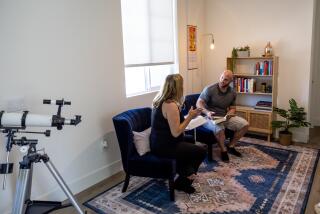Builder Modeling Itself on Firm It Took Over
- Share via
It looked like another typical corporate acquisition when giant Kaufman & Broad Home Corp. of Los Angeles purchased a smaller but fast-growing Texas home builder named Rayco.
But a little more than a year after the deal was completed, it’s hard to tell which company was actually taken over.
Rayco’s innovative building techniques and operating strategies and extensive use of consumer surveys are rapidly spreading throughout Kaufman & Broad, one of the nation’s largest home builders. Kaufman & Broad senior managers frequently visit and call Rayco executives for advice and now meet every morning--just as the Rayco executives do in their San Antonio offices. It seems the only thing Kaufman & Broad executives have not picked up from their Rayco counterparts is a Texas drawl.
“There are some great teachers in San Antonio,” said Kaufman & Broad Chairman Bruce Karatz.
The lessons being learned from Rayco are being used to infuse a new sense of discipline and predictability into Kaufman & Broad’s traditionally freewheeling corporate operations, as well as to boost the company’s long-moribund stock price.
They could also change home building and home-buying habits throughout California, where the company is the industry leader. For example, imagine home buyers traveling to a giant showroom to see and select the standard features and options--such as a front porch--they want included in their yet-to-be-built homes. That’s what thousands of Rayco customers in Texas have done for years.
*
Kaufman & Broad had already undertaken some changes on its own before it acquired Rayco in a $104.5-million deal announced in January 1996. But the Texas builder serves as a working model of what Kaufman & Broad has long envied and wants to become--an efficient, predictable, high-profit machine.
“We will get where we want to be much faster because of the San Antonio acquisition,” said Michael F. Henn, chief financial officer.
California’s real estate bust of the early 1990s undermined Kaufman & Broad’s earnings and exposed many operating weaknesses and inefficiencies. For example, the firm in some cases didn’t know how much plywood it took to a build a house--making it hard to estimate costs.
“Maybe it takes a recession to seriously rethink the model” under which the company operated, said Karatz.
When it came time to search for a new model, Karatz and his top managers looked to Rayco Ltd.
Although it focuses on a single market, San Antonio, Rayco had garnered a nationwide reputation for applying innovative methods--at least for the home-building industry--and generating impressive financial results. Rayco’s share of the new home market in San Antonio has often exceeded 50% in recent years.
“No other builder comes close to that,” said Irvine-based home-building consultant Jeff Meyers.
Rayco’s operating profit margins have averaged around 10% to 12% over the last four years. In contrast, Kaufman & Broad profit margins have averaged below 5%.
In a rare use of consumer research in the home-building industry, Rayco conducts extensive surveys of all recent home buyers--including purchasers of existing homes and houses constructed by rival builders--to help design and price its product.
*
Starting from a basic, low-priced model, Rayco, which has been renamed Kaufman & Broad of Texas, has its customers pick standard features, as well as the options for which they are willing to pay extra. Those features--everything from garage doors to porch lights--are on display in a huge San Antonio showroom.
“We have had people take three or four days” to decide, said Buddy Goodwin, who heads the Rayco operation. “Husbands and wives have different issues that have to be resolved. We let them deal with it themselves.”
Since Rayco will not build a home before it’s sold, the company has been able to develop an efficient, factory-like production schedule that allows it to avoid costly last-minute scrambles to fill customer orders. The system also cuts down the cost of getting stuck with an unsold home.
Kaufman & Broad has put some of Rayco’s principles to work in its Antelope Valley operations, which were on the verge of being closed down after years of stagnant sales.
After conducting a survey of all recent buyers, a la Rayco, Kaufman & Broad managers came up with plans for a series of homes that cut down on pricey standard options--such as soaring vaulted ceilings--but offered buyers more floor space. The most popular model is a 1,400-square-foot home that carries a base price of less than $95,000.
*
After opening in January, the new homes at Kaufman & Broad’s West Lancaster development are selling at a rate of about three a week, compared with a rate of less than one a week for the standard product, according to Richard “Pete” Peterson, who heads the Antelope Valley operations.
“It works,” said Peterson of the Rayco model. “We have brought some predictability and consistency to this market.”
Although the West Lancaster homes are simple in styling, the low prices and the ability to pick and choose features have proved popular with buyers.
Stephanie and Bill Cataloni, for example, decided they wanted an island counter in their kitchen--an extra $700--but not a three-car garage--a $4,000 option. When it was all done, they spent about $109,000--including about $5,000 in optional items--for a four-bedroom, 1,600-square-foot home.
“It’s wonderful,” said Stephanie Cataloni, a 31-year-old school district employee, of her first home.
Kaufman & Broad has employed parts of Rayco’s methods and other new strategies in other markets with promising results. In Colorado, for example, the company opened up a Rayco-like showroom and three new developments that relied heavily on home buyer surveys. Sales in those developments are running 42% higher than in the company’s traditional projects.
Many industry analysts said they expect Kaufman & Broad to reap impressive results when it fully embraces the new corporate methods. The company, the largest home builder in California, with about 9% of the new-home market, “could double their market share,” said Meyers, the housing consultant.
Despite impressive results in West Lancaster and other markets, Wall Street has remained cautious about Kaufman & Broad’s new programs. During the last two years, the company’s stock price has been stuck in a narrow range in the low to mid-teens. On Friday, Kaufman & Broad shares closed up 12.5 cents at $13.875 on the New York Stock Exchange.
“We need a quarter or two of significant evidence that the strategy is paying off,” said Karatz, who has grown frustrated over his company’s sluggish stock price. “They want to see some tangible results before their enthusiasm grows.”
*
While Wall Street waits to see the results of Rayco’s methods, other builders are quickly adopting the same techniques, which could eat away at the competitive lead Kaufman & Broad hopes to gain.
Newport Beach-based Fieldstone Communities, for example, saw sales double last year at its Cypress development, where the homes were designed with the help of surveys and customers selected many features, said regional manager Frank Foster, who had met with Rayco executives numerous times over the years. The company also has opened up a 10,000-square-foot showroom in Yorba Linda.
“Instead of the builder deciding what will go into the house . . , we let the home buyer decide,” Foster said. “This is what we learned from Rayco.”
More to Read
Inside the business of entertainment
The Wide Shot brings you news, analysis and insights on everything from streaming wars to production — and what it all means for the future.
You may occasionally receive promotional content from the Los Angeles Times.










